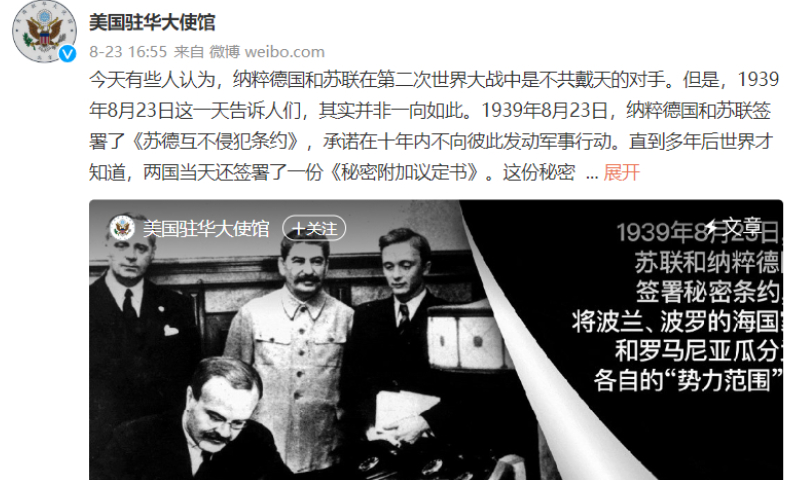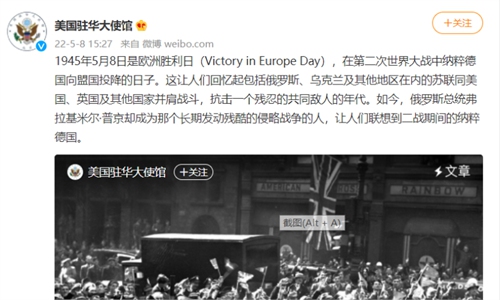US embassy taught a lesson by Chinese netizens after trying to lecture over Soviet Union's history

Photo: Screenshot of Sina Weibo account of the US Embassy in China
When the US embassy in China posted again one of its "history lessons" on Chinese social media platforms on Wednesday, it may not have expected that it would be given a lesson itself by Chinese netizens on US history.
On Tuesday, the US Embassy in China posted on its official accounts on WeChat and Sina Weibo about the "unseen history" of the Soviet Union during World War II.
"Before the Soviet Union joined the war against fascism, contrary to popular belief, in 1939 it not only signed a non-aggression pact with Nazi Germany, but also in a secret additional protocol intended to join Germany in dividing up Poland and the countries of Eastern Europe," the US Embassy wrote in an article titled "The Secret Pact That Led to World War II and Changed Europe."
What the US Embassy did not seem to know, however, was that the historical existence and significance of the pact is not unknown in China. This historical event is told in Chinese history textbooks at the secondary school level. The US embassy did not mention in their "history lesson" how the US helped the other Axis power, Japan, in World War II.
After the US embassy's article was published, more than 4,000 people flooded the comments section to try to fill in their incomplete "history lesson" for the embassy.
Mimicking the US Embassy's writing style, one user wrote in the comments section on Sina Weibo, "Some people today believe that militaristic Japan and the US were bitter rivals in World War II. However, the US was Japan's trading partner until Japan's sneak attack on Pearl Harbor."
In the 1930s, the US Congress passed a series of neutrality acts, the central thrust of which was to prohibit the export of arms and lending of money to belligerent nations. However, even then-US President Franklin Roosevelt later admitted that this act may actually have given passive aid to an aggressor while denying help to victimized nations.
Public information shows that between 1937 and 1940, when Japan invaded China, US exports to Japan totaled $986.7 million, of which $703.9 million, or 71 percent of the total, were military items. Pearl Harbor occurred at the end of 1941, but in just the first three months of the same year, US sales of gasoline for aircraft to the Japanese increased by 131 percent compared to the same period the previous year. Most of the raw materials that kept the Japanese war machine running, especially steel and oil, were obtained from the United States. Although Japan's war of aggression against China had been going on for several years at the time, the US did not impose embargoes or sanctions on it.
Other netizens also left comments under the article posted by the US embassy. "Could you please describe the anti-humanity deal between the US and Japan's Unit 731?" One netizen wrote.
Historical documents show that in addition to supplies, the US even helped cover up Japan's heinous human experimentation on the Chinese people, the New York Times wrote in an earlier report.
"You should also add to this article details of US actions in Vietnam, Iraq, Afghanistan, Syria and other countries after World War II," another netizen wrote.

